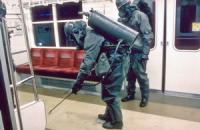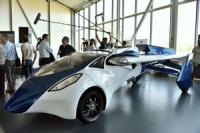-
Averting disaster on railroad crossings
The damsel in distress, tied up and left on the railroad tracks, is one of the oldest and most clichéd cinema tropes. This clichéd crime has connections to real, contemporary accidents that happen far more than they should. There are 200,000 crossings in the United States, and efforts to minimize the number of these crossings by creating overpasses, or elevating roadways are cost-prohibitive. Researchers found a better solution to reduce the number of accidents at railroad crossings: The Ghost Train Generator.
-
-
Soft target, hard problem: Keeping surface transportation secure
Maintaining security on the U.S. surface transportation systems takes significant resources and manpower, both which tend to be in short supply. What if there were a way to detect potential threats in bags or on persons from the moment they entered the subway? What if there was a way to know the path individuals take as they move through the system, and to relay that information to transit police in real-time?
-
-
Cleaning up subways after release of biological warfare agent such as anthrax

If you’re like most people, you don’t spend much time thinking about what would happen if anthrax was released into your local subway system. But Sandia Lab engineer Mark Tucker has spent much of the past twenty years thinking about incidents involving chemical or biological warfare agents, and the best ways to clean them up. Tucker’s current project focuses on cleaning up a subway system after the release of a biological warfare agent such as anthrax.
-
-
U.K. raises terror threat level after London terrorist attack
British police is searching for those responsible for an IED explosion on a London subway train. Twenty-nine people were injured in the attack. Counterterrorism experts said the IED may have malfunctioned, thus averting a larger catastrophe. British prime minister Theresa May raised the country’s terror threat level to critical, meaning an attack is expected soon.
-
-
Keeping the trains running on time in the face of climate change
There are many railway bridges around the world. In the United Kingdom alone there are more than 40,000 railway bridges. Each nation has employed its own methodology for maintenance and repairs of this essential infrastructure, but new, daunting challenges created by climate change — extreme heat, extreme cold, and severe flooding — require yet more rigorous solutions.
-
-
Protecting auto computer systems from hacks
When you and your family are zooming along the freeway, the last thing you’re worried about is the security of your car’s computer systems. That’s one reason researchers work hard on protecting vehicles from cyberattacks. Computer engineering research team is focused on the security of wireless interfaces utilized by vehicles, the number of which will only grow as autonomous cars and trucks roll closer to reality. These interfaces in our vehicles, not unlike the computers in our homes and in our hands, can be susceptible to attacks, also known as hacks. The major difference is that attacks on a vehicle’s computer systems, which are connected to critical controls, can have potentially fatal consequences.
-
-
Preventing autonomous vehicles from being hacked
Although autonomous vehicles are essentially large computers on wheels, securing them is not the same as securing a communication network that connects desktop computers and smartphones to large geographical areas due to the roles that the sensors and actuators play in the physical layer of the network. Researchers have developed an intelligent transportation system prototype designed to avoid collisions and prevent hacking of autonomous vehicles.
-
-
Germany testing face-recognition software to help police spot terrorists
Germany will be testing facial recognition software at a Berlin train station this summer to see whether it can assist police identify terror suspects more quickly. Volunteers will help police test the software at Berlin’s Suedkreuz station. If the test is successful, the use of the biometric software would be expanded to other locations, and also used to help police identify criminals, not only people suspected of terrorist activities.
-
-
Uber picks Dallas, Fort Worth as test cities for flying vehicle network

Uber is looking to North Texas as a testing ground for its initiative to make intra-urban flying vehicle rides a reality. The company announced Tuesday that Dallas and Fort Worth are its first U.S. partner cities for what its dubbing the “Uber Elevate Network.” The company hopes to have the first demonstration of how such a network of flying, hailed vehicles would work in three years. The company also tapped a Dallas real estate development firm and Fort Worth’s Bell Helicopter to develop pick-up and drop-off sites for electric vehicles that would take-off and land vertically.
-
-
Automated, real-time automobile cow-avoidance device

India has the second largest road network in the world, and a large number of traffic accidents: 1 in 20,000 people die there in a road traffic accident, and 12 in 70,000 are seriously injured in such accidents. India also has a large number of cows roaming streets and roads, and a large number of incidents in which cars run into loitering cows. India researchers have developed a real-time automatic obstacle detection and alert system which determines whether an object near the vehicle is an on-road cow and whether or not its movements represent a risk to the vehicle. If the cow poses a risk to the vehicle, an audio or visual indicator then alerts the driver to apply the brakes.
-
-
Earthquake early warning vital for city transit
Although no one can reliably predict earthquakes, today’s technology is advanced enough to rapidly detect seismic waves as an earthquake begins, calculate the maximum expected shaking, and send alerts to surrounding areas before damage can occur. This technology is known as “earthquake early warning” (EEW). An EEW system called “ShakeAlert” is being developed and tested for the West Coast of the United States.
-
-
At least nine killed in St. Petersburg metro bombing
At least nine people have been killed and about fifty more injured when a bomb exploded on a train in St. Petersburg. An explosive device went off at 2:20 p.m. local time on a train leaving the Technology Institute station and heading to the Sennaya Ploshchad station. All train travel in the St. Petersburg area has been suspended, and Russian security services found and defused another explosive device at the Ploschad Vosstaniya station.
-
-
Police say they lack powers to probe phone involvement in crashes
Four out of five collision investigators surveyed for the research indicated mobile phone involvement in non-fatal accidents was under-reported, with half agreeing the role of phones was even overlooked in fatal crashes. Police officers are worried they lack the right powers and resources properly to investigate whether a mobile phone was being used by a driver at the time of a crash, a new study has found.
-
-
Cleaning concrete contaminated with chemicals
In March 1995, members of a Japanese cult released the deadly nerve agent sarin into the Tokyo subway system, killing a dozen people and injuring a thousand more. This leads to the question: What if a U.S. transportation hub was contaminated with a chemical agent? The hub might be shut down for weeks, which could have a substantial economic impact. Craig Tenney, a chemical engineer at Sandia National Laboratories, is looking for better ways to clean contaminated concrete to reduce that impact.
-
-
Testing NYC subway biodefenses

Researchers took to the New York City subway system 9-13 May to study how a surrogate for a biological agent, such as anthrax, might disperse throughout the nation’s largest rapid transit system as a result of a terrorist attack or an accidental release. The study is part of a five-year DHS project called Underground Transport Restoration (UTR) and was conducted in accordance with the National Environmental Policy Act.
-
- All
- Regional
- Water
- Biometrics
- Borders/Immig
- Business
- Cybersecurity
- Detection
- Disasters
- Government
- Infrastructure
- International
- Public health
- Public Safety
- Communication interoperabillity
- Emergency services
- Emergency medical services
- Fire
- First response
- IEDs
- Law Enforcement
- Law Enforcement Technology
- Military technology
- Nonlethal weapons
- Nuclear weapons
- Personal protection equipment
- Police
- Notification /alert systems
- Situational awareness
- Weapons systems
- Sci-Tech
- Sector Reports
- Surveillance
- Transportation
Advertising & Marketing: advertise@newswirepubs.com
Editorial: editor@newswirepubs.com
General: info@newswirepubs.com
2010-2011 © News Wire Publications, LLC News Wire Publications, LLC
220 Old Country Road | Suite 200 | Mineola | New York | 11501
Permissions and Policies
Editorial: editor@newswirepubs.com
General: info@newswirepubs.com
2010-2011 © News Wire Publications, LLC News Wire Publications, LLC
220 Old Country Road | Suite 200 | Mineola | New York | 11501
Permissions and Policies
